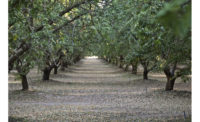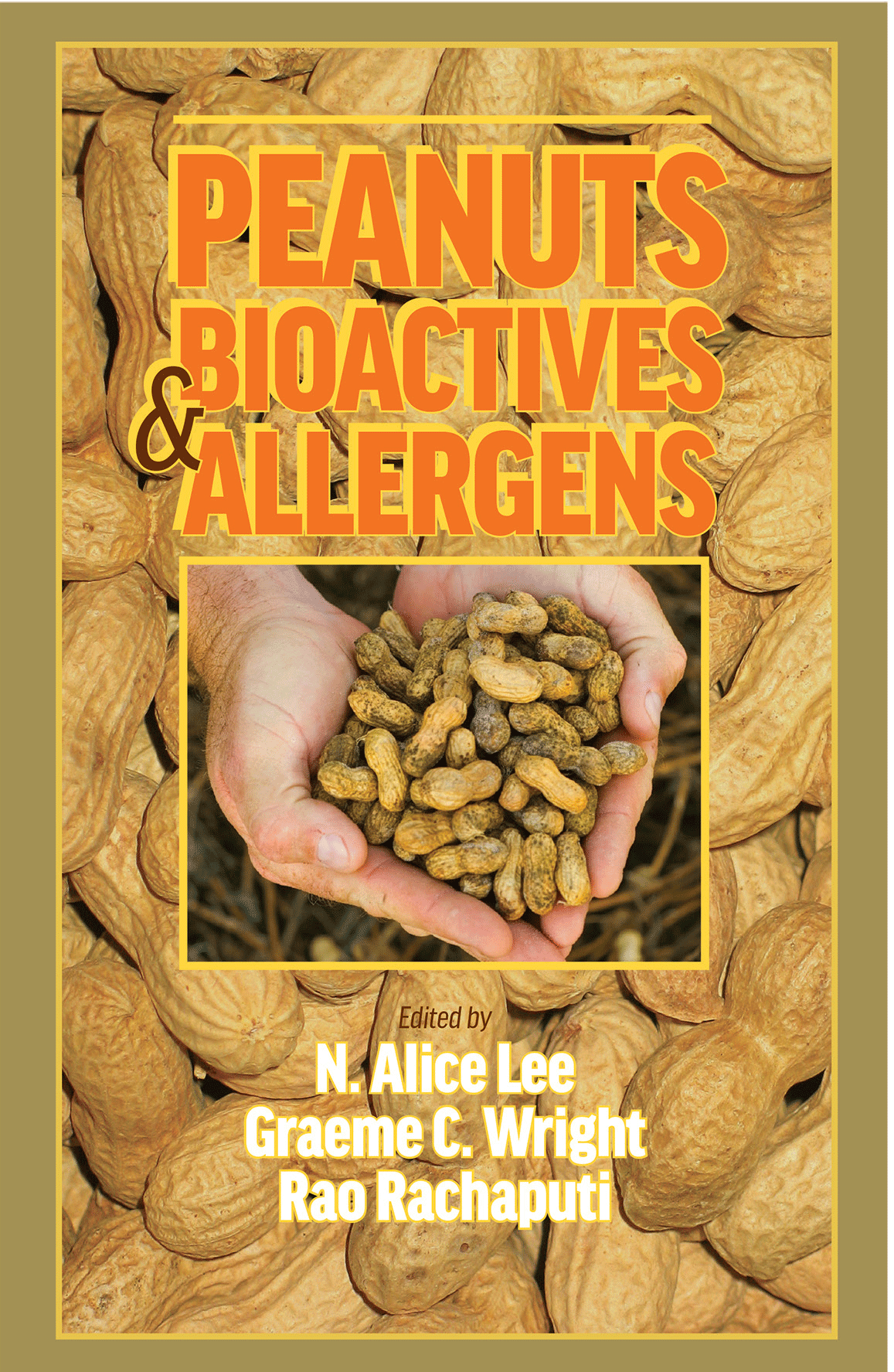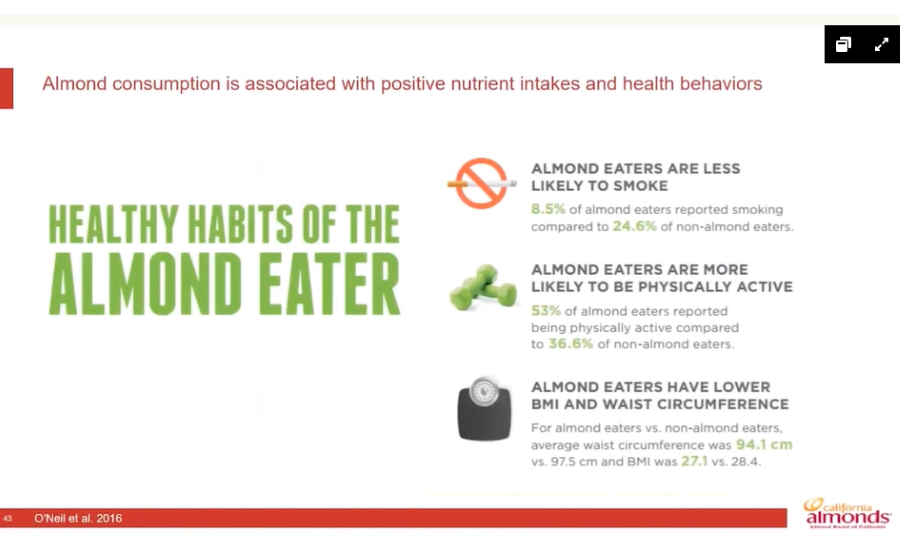Almond Board 2021 Virtual Orchard Tour covers everything to know about almonds
















The California Almond Board recently hosted a virtual orchard tour for media and nutrition professionals, from May 18–19, 2021. This was the Almond Board’s first virtual tour; in the past, it has hosted in-person events, but due to the COVID-19 pandemic, the decision was made to host a virtual event this year.
The event kicked off at 11 a.m. EST on May 18 with a brief overview on almonds, as well as a presentation on the lifecycle of almonds from tree to table. Danielle Veenstra of the Almond Board, a third-generation almond farmer herself, talked about the annual almond production cycle, including almond farmers and responsible farming practices. She also spoke about other products grown in the orchard, the industry’s zero waste initiative, and how using coproducts plays an important role in reducing almonds’ carbon footprint.
Attendees learned that almonds are actually similar to peaches—they’re fuzzy on the outside, in their original state—and that 90 percent of almond farms are family-owned. Almond orchards are commercially productive for about 25 years, and can begin bearing almonds three years in, with its peak production at 12 years in. The almond life cycle includes bloom, nut development, harvest, processing, storage, and other stages.
At 12 p.m. EST, Dr. Swati Kalgaonkar of the Almond Board provided a full review of the almond nutrition research program, from origins in heart health to the latest cutting-edge health studies. Kalgaonkar spoke about plant-based diets, and the health benefits of almonds, which include lowering LDL (“bad cholesterol”) as well as total cholesterol levels. The Almond Board recently did a study on almonds in lowering the amount of wrinkles people have, as well.
At 11:30 a.m. EST on May 19, the day two kickoff presentation, entitled “Why California?”, was presented by Karen Ross of the California Department of Food and Agriculture (CDFA). She spoke about the advantages behind the environmental and socially responsible requirements for grows in California, how the CDFA is protecting and promoting agriculture, and the collaboration between the almond industry and California towards continuous improvements.
Because California has a Mediterranean climate, crops can be harvest almost any day of the year there. The state has invested almost $90 million in partnership with growers to reduce energy and water use, as well as greenhouse gas emissions, in almond orchards. In addition, many orchards are already on efficient irrigation systems and have taken advantage of the latest technology in their farms.
In the last two decades, almond growers have reduced the amount of water needed to grow one pound of almonds by 33 percent, and by 2025, the goal is to reduce water use by an additional 20 percent.
At 1:00 p.m. EST, Dr. Kalgaonkar returned to explore past and emerging almond nutrition research studies related to factors that can improve cardiometabolic health. Cardiometabolic health is your collective state of health, including the heart, lipids, blood vessels, pancreas, liver, and healthy body composition.
Tour attendees learned that nuts are a good source of unsaturated fats, despite the stigma surround nuts—that because they’re high in fat, they will lead to weight gain. Studies indicated that people who had a serving of nuts per day did not experience a change in body weight, and actually experienced a significant decrease in body fat percentage.
In 2003, the FDA approved a heart health claim for almonds, which says “scientific evidence suggests, but does not prove, that eating 1.5 ounces per day of most nuts as part of a diet low in saturated fat and cholesterol may reduce heart disease.”
Kalgaonkar says that snacking is a way of life for Americans: the majority of the U.S. population consumes three meals a day plus one snack.
“Swapping out common empty-calorie snacks for almonds … can have significant benefits, including improved satiety, healthy cholesterol, and improved nutrient intake and diet quality,” she said.
On average, 25 percent of daily calories come from snacks, and most frequently-consumed snacks are cookies and brownies, ice cream and frozen desserts, cakes and pies, chocolate, doughnuts, pastries, and sweet rolls.
The 2:15 p.m. EST session covered the uses for almond hulls and shells, aka almond co-products. Josette Lewis of the Almond Board discussed the Board’s investment in research around coproducts, such as dietary fibers, sweeteners, larvae for animal feed, and compostable plastics.
She said that putting co-products to optimal use is part of the commitment to zero waste by 2025 plan (Orchard 2025 Goals), and that the kernel of the almond—aka what you’d find in a grocery store—is only a third of what comes out of the orchards each year. The hulls are the “fleshy” part of an almond, similar to peaches and apricots, and they can be used for animal feed.
The Virtual Almond Board Tour closed with a session on “Working Together for a Sustainable Future,” where the growers featured in the other sessions convened to share insights on the industry’s future. The Almond Board’s Chair, Kent Stenderup, and Director of Sustainability & Environmental Affairs, Gabriele Ludwig, moderated the session. Other participants included Julia Violich, Capay Farms; Matt Angell, Pacific Farming Company Inc.; Ben King, Pacific Gold Agriculture; and Christine Gemperle, Gemperle Orchards.
Interested food and nutrition professionals can still register to access the content on-demand within the event portal until June 20, 2021.
Looking for a reprint of this article?
From high-res PDFs to custom plaques, order your copy today!
















